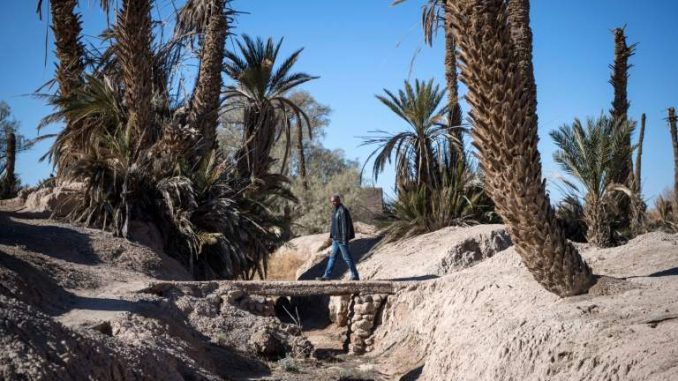
During the 20th century, the country lost two thirds of its 14 million palm trees, mainly due to increasingly frequent drought cycles.
Stems of palm trees lie on yellowish soil in front of the ruins of an abandoned adobe house in an isolated, arid region of south-eastern Morocco. This scene of misery depicts the fate of oases threatened with extinction by climate change. “I grew up in this oasis and witnessed its gradual disappearance,” regrets Mohamed El Houkari, a resident of the oasis of Skoura, which has some 25,000 inhabitants. “The threat of its disappearance is very real,” the 53-year-old activist is alarmed in front of a dry irrigation canal.
For centuries, Moroccan oases have been home to human settlements, agricultural activities and an architectural and cultural heritage, benefiting from their location on the road of trans-Saharan commercial caravans. Today, in Skoura, only the olive trees that do not require much water still resist the shade of the palm grove, which is otherwise a landscape of cracked earth.
Yet, until the 1980s, “pomegranate and apple trees grew here,” recalls Mohamed. With increasingly frequent and devastating cycles of drought, the oases, once shields against desertification, are now “threatened with extinction because of the considerable impact of high temperatures on water resources,” recently alerted the NGO Greenpeace.
Over the last century, Morocco has already lost two-thirds of its 14 million palm trees, according to official figures. “Oasis activities rely on groundwater, which is generally fed by [mountain] snow. They have suffered with global warming in the 1980s and 1990s,” said Lahcen El Maimouni, dean of the faculty of Ouarzazate, speaking at a conference on solidarity tourism in oases.
This 50-year-old settled with his family twenty-five years ago, “when the area was green and water was abundant. “But the drought destroyed everything,” he sighs, regretting the high cost of the electric pumps used to draw water ever deeper. More than 40 meters is now the depth to find water, compared to 7 to 10 meters in the 1980s, according to some residents.
The intensive use of electric pumps has also contributed to the overexploitation of the water table,” says Abdeljalil, a 37-year-old electrician in Marrakech and Agadir (south), where he spends most of his time. “Our life is no longer here! “he says. Mohamed, for his part, deplores the abandonment of traditional methods that allowed water to be distributed “economically and rationally”, referring to an old canal irrigation system called “Khatarat”.
On the horizon are the snow-covered peaks of the Atlas Mountains. Not enough, however, to feed the dry beds of the wadis crossing the oasis. The effects of the drought are visible along the curvy road from Marrakech to Ouarzazate, 40 kilometres from Skoura.
To rehabilitate the oasis area, the National Agency for the Development of Oasis Areas and the Argan Tree (Andzoa) launched a “major program in 2008 with the planting of three million trees, an objective reached in 2019,” says Brahim Hafidi, its director general. “We have set ourselves the goal of mobilizing one billion cubic meters of water by the end of 2020”, including the construction of dams and the rehabilitation of irrigation canals. A “very advanced program,” he says.
Water shortages do not only threaten oases. The semi-desert city of Zagora (south) experienced in 2017 “thirst demonstrations” against repeated water cuts. At the beginning of January, Morocco launched a national drinking water supply and irrigation program for 2020-2027, worth 10.9 billion euros.

Be the first to comment